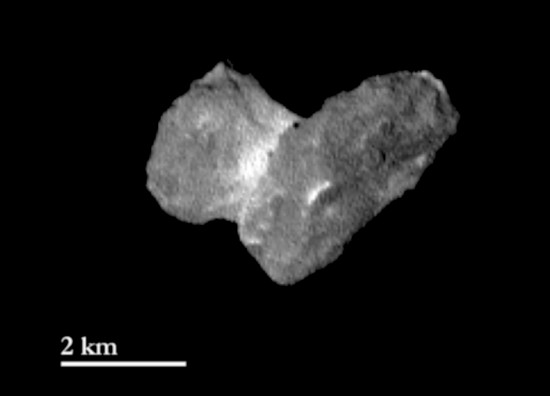
Comet 67P/Churyumov–Gerasimenko from 1950 kilometers on July 29, 2014. Credit: ESA/Rosetta/MPS for OSIRIS Team MPS/UPD/LAM/IAA/SSO/INTA/UPM/DASP/IDA
Aug 1, 2014
The comet is currently 544 million kilometers from the Sun.
Comet 67P/Churyumov–Gerasimenko (67P/C-G) is about one year away from perihelion, or its closest approach to the Sun. As seen in the image above, there is also a “waist” between the two halves of the comet that appears to be glowing more brightly than the rest of the nucleus.
Even at its great distance from the Sun, the comet is beginning to display a coma approximately 150 kilometers in diameter. According to the European Space Agency (ESA) mission team, “increasing warmth from the Sun causes surface ices to sublimate (change directly from a solid to a gas), and the gas escapes from the rock–ice nucleus. As the cloud of gas flows away from the nucleus and out into space, it also carries tiny dust particles: together, these slowly expand to create the coma.”
This is an odd statement, since Rosetta’s infrared sensor detected signals that put the comet’s external temperature close to -70 Celsius, and its current position places it almost as far as the orbit of Jupiter. If sunlight were sublimating water ice at that distance, then Jupiter’s icy moons would be rocky bodies by now. That is, if, as the consensus astronomical community presumes, they are billions of years old.
However, if, like Comet 103P/Hartley, 67P/C-G is spewing carbon dioxide instead of water vapor, the readings could make more sense. Carbon dioxide was the predominant gas seen in the infrared spectrum of Comet Hartley. The amount of carbon dioxide was so high that it prompted the mission’s research group to suggest that it, and not water, could be a common characteristic of other comets. Perhaps 67P/C-G is confirming that hypothesis?
Since 67P/C-G is only the sixth cometary nucleus ever seen, there could be more surprises in store. Ground-based telescopic spectral analyzers are not able to detect carbon dioxide in space, and space telescopes are not tuned to that infrared frequency. When Deep Impact encountered Comet 9P/Tempel, the side of the comet that appeared to be “enhanced” by carbon dioxide was in darkness. No readings could be taken.
Something else never flown on a cometary mission before is the Langmuir probe (LAP) on Rosetta. The LAP is made up of two titanium spheres that protrude from Rosetta’s main body. They are separated from the spacecraft and from each other by several meters. The instrument will enable Rosetta to measure electron density, electron temperature, plasma drift velocity, and plasma density variations. The two spheres are separated from each other so that plasma flow velocity and electric fields can be detected.
Many Picture of the Day articles are concerned with the misrepresentations and misinterpretations by scientists when it comes to comets. A major issue of fair use policy and public access to information gathered by publicly funded institutions was debated in the past by Electric Universe advocates and some members of those institutions related to comets.
An October 2007 Picture of the Day described the behavior of Holmes 17P and noted that many of the observed phenomena could be explained by an electrical theory of comets. Since these pages were first published, Electric Universe theorists have challenged the prevailing “dusty snowball” cometary theory.
Comets becoming active at long distances from the Sun—such as 67P/C-G—contradict the idea of a frozen ball of ice that only grows a tail or emits jets of gas when it gets close enough for the Sun’s heat to sublimate its surface.
Stephen Smith












